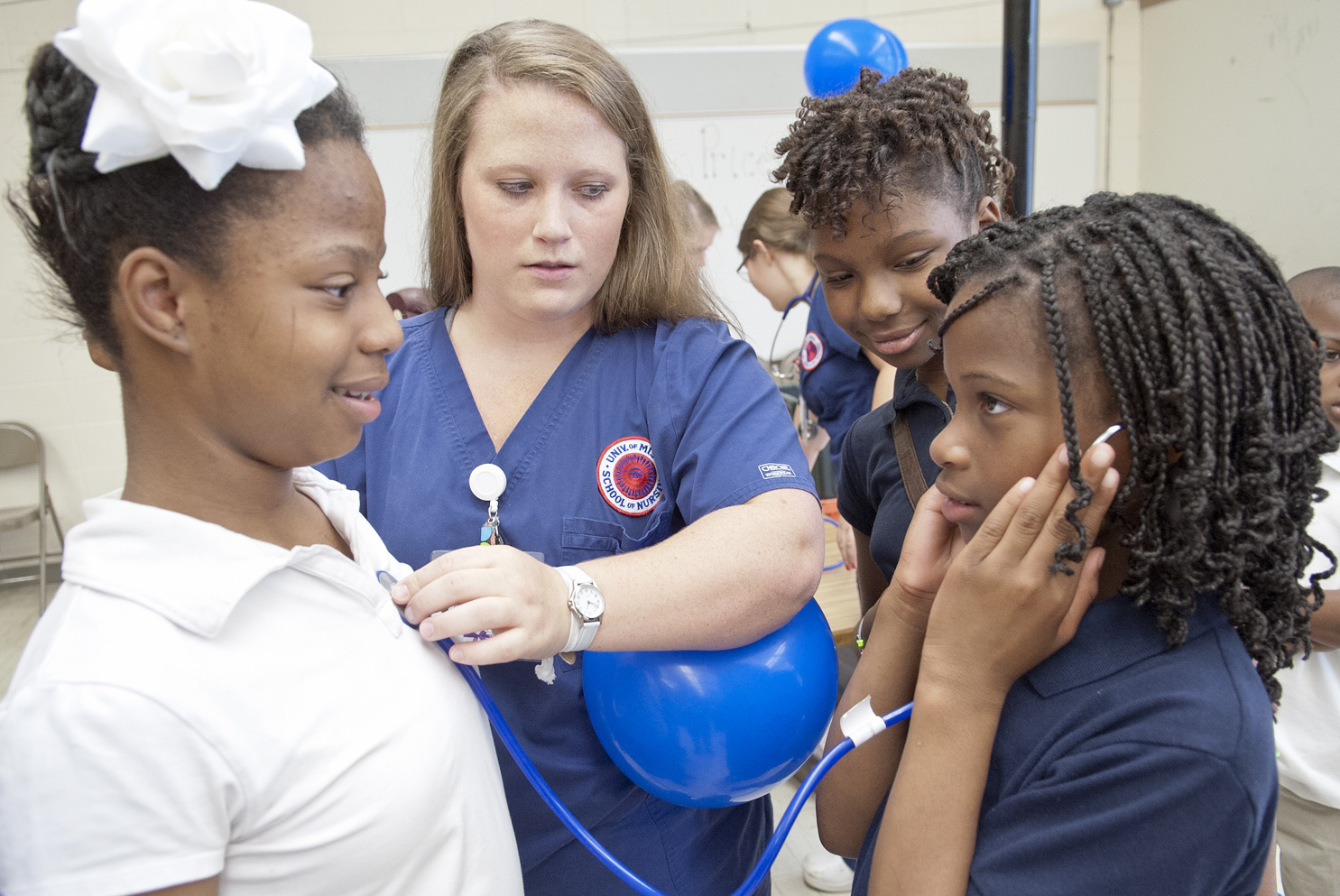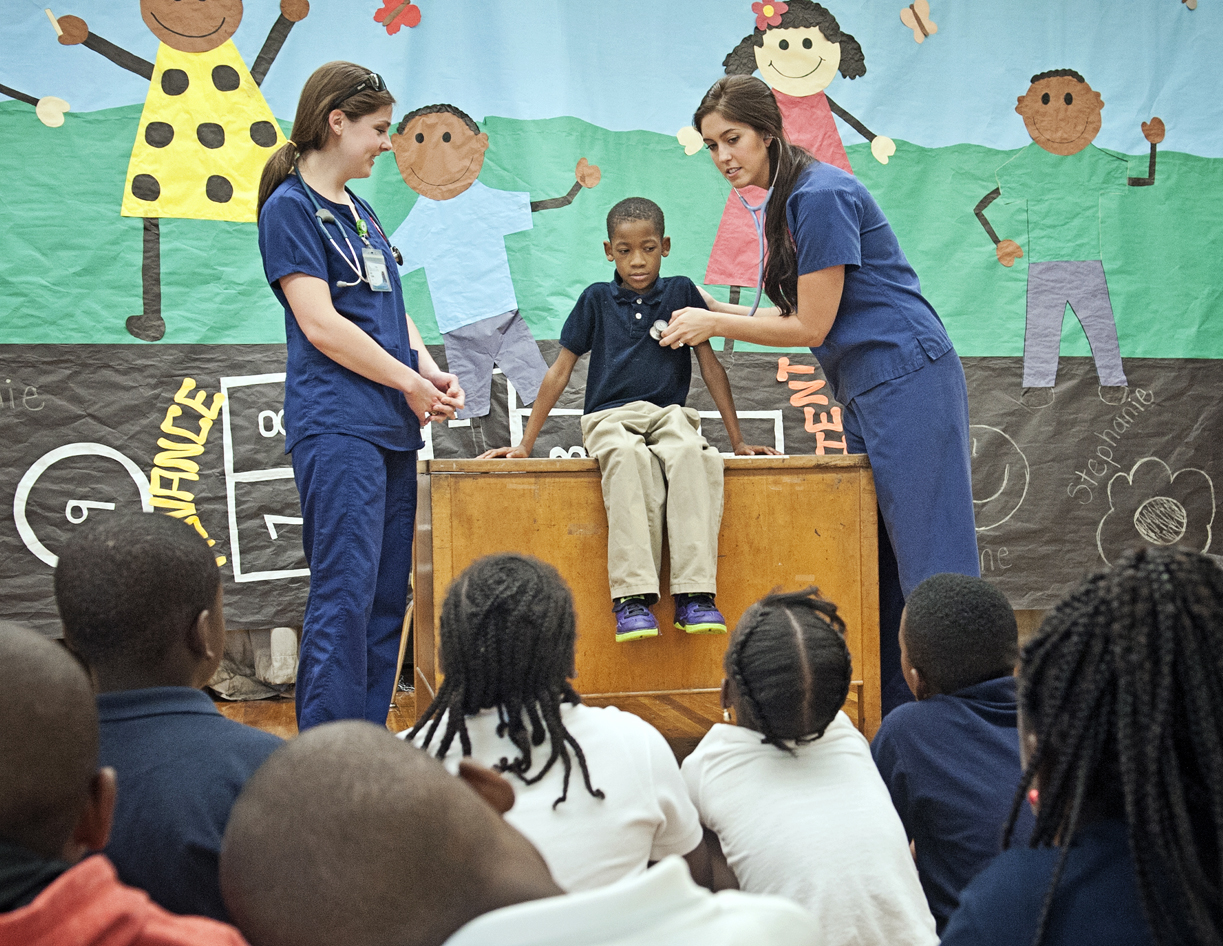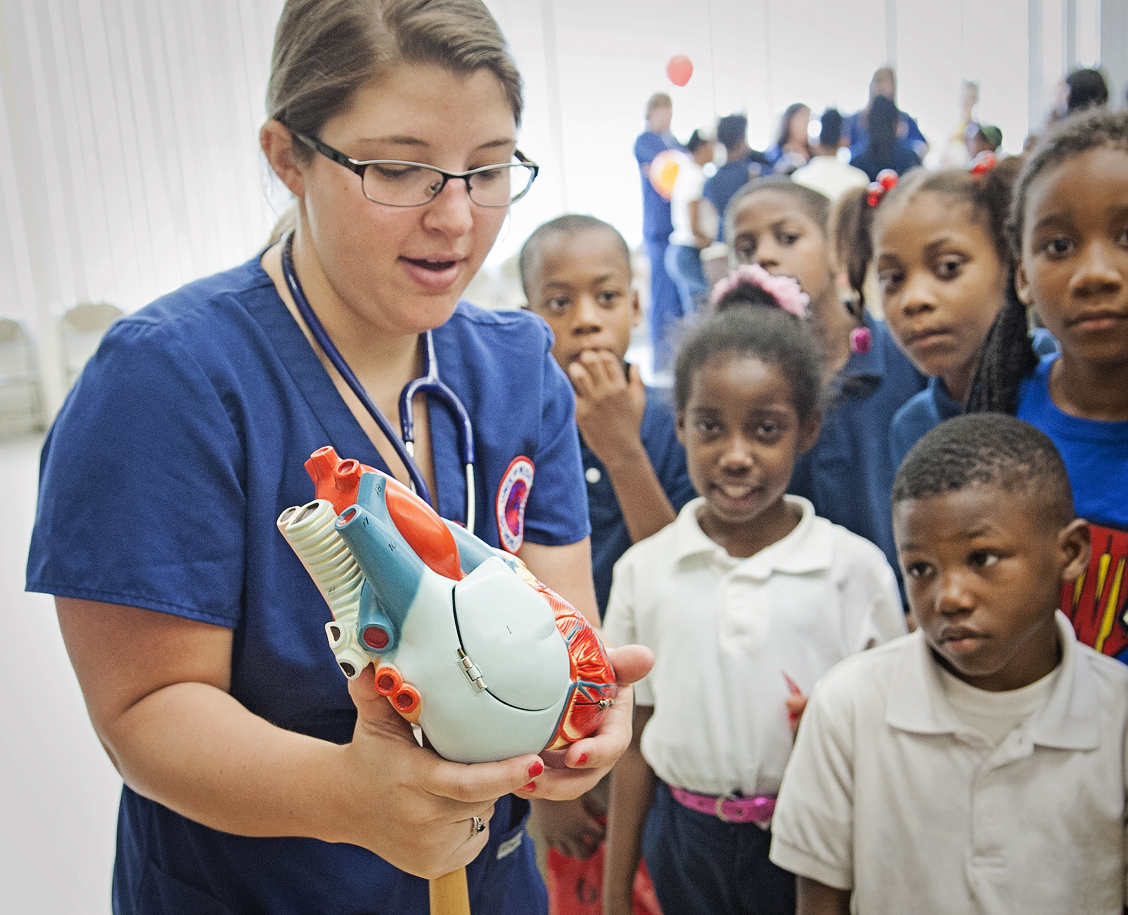UMMC students help local elementary children ‘discover’ nursing

A sea of little hands shot into the air when senior nursing student Rebecca Ross asked the third grade class at Jackson’s Brown Elementary School if they knew what nurses do.
“They take your temperature.” ”They give shots.” “They help you get well.”
Then Ross asked the class where nurses work.
“In school.” “At a hospital.” “In a clinic.” “At home.”
Then, after a short skit in which she acted as a nurse practitioner to demonstrate why good math, writing and communication skills are important in the nursing profession, Ross asked the third graders how many of them wanted to be nurses when they grew up.
More than a dozen girls – and boys – raised their hands.
It’s an encouraging start to the first year of a project designed to build awareness of nursing as a potential career for students in underserved neighborhoods of the Capital City. But what separates the Discover Nursing Day initiative, now part of the curriculum in the School of Nursing at the University of Mississippi Medical Center, from similar efforts is that the program initially was conceived and developed by senior nursing students.
“Leadership and management concepts are sometimes difficult to communicate when you’re sitting in a classroom,” said Dr. Kate Fouquier, assistant professor of nursing who teaches the leadership and management class in the SON. “Discover Nursing Day is more of a real-life experience, and the students get to put into practice the skills they’re taught in the classroom.
“Our students have really just responded to the group of kids in so many ways, and it’s been a real honor for me to see them take the leadership professional role. It’s really been rewarding.”
The germ of the idea for Discover Nursing Day grew out of a breakthrough training project sponsored last semester by the Mississippi Association of Student Nurses. Children at the three Jackson Public Schools that house a clinic staffed by School of Nursing faculty were encouraged to send questions about nursing to SON students at UMMC. In turn, the nursing students responded to the inquiries with letters of their own – more than 160 in all.

“We wanted to do a little more with these students,” said Presly Forrester, a senior nursing student. “We knew we wanted to do a project at one of the school-based clinics, but we weren’t sure what the vision was.”
So Forrester and classmate Katie Lloyd – both UMMC chapter officers in the MASN – gave a presentation at a Theta Beta Chapter of Sigma Theta Tau International board meeting and asked for the board members’ support.
“When they began to describe the Discover Nursing Day project, it took on a life of its own,” said Fouquier, who serves as vice president of the Theta Beta chapter. “It became much more complicated than they had initially planned, but they did an outstanding job, and we incorporated it into the Leadership Management Program.”
An event initially intended as a pilot project at one school suddenly was scheduled at all three school-based clinic sites: Johnson Elementary School on March 26, Brown Elementary School on March 31 and Rowan Middle School on April 29. Forrester and Lloyd were instantly thrust into the position of coordinating the program.
They divided the 73 senior nursing students into teams, established team leaders, and devised four separate stations to best communicate the advantages of a nursing career to students ages 8-12:
• A photo booth station. Full-size stand-up illustrations of nursing professionals have cutouts for the children to push their heads through so they can have pictures taken of them as “grown-up” nursing professionals.
• A healthy living station. Pamphlets with facts and information about good nutrition produced by the Mississippi State Department of Health are collected in “goody bags” given to the children. Giveaways donated by the School of Nursing also are included, such as pedometers at Johnson Elementary, which has a walking track nearby, and highlighters for the older students at Rowan Middle School.
• A skit station. Nursing students demonstrate what nurses typically do in a clinic setting and explain the importance of obtaining a good education.
• A “Mister Body” station. A mannequin that displays the veins, muscles and organs of the body is perhaps the most popular part of the program. Students get to use stethoscopes to listen to each other’s heart and lungs, and a “wearable” model with felt organs attached by Velcro help them understand where different body parts are located.

“They get really excited when they get to see Mr. Body,” Forrester said. “They really get to see everything that’s behind the skin. Their classmates will point out, ‘This is your lung, this is your kidney, your heart,’ etc.”
Lloyd said the best part of the program is the opportunity to interact with the potential nursing professionals of the future.
“I think everybody enjoys working with kids and doing service projects,” she said. “When we first came to work with these kids (at Johnson Elementary), we asked them what nurses do. They said, ‘They do nasty stuff.’ But after we interact with them a little more, we give them the idea that we help people. We give them the idea that it’s a great profession to grow up and become a part of.”
Fouquier said the SON’s rich diversity allows it to better communicate with the younger students.
“Even though the schools have primarily African-American students, our diversity helps us relate to them,” she said. “For example, they have the opportunity to see men in nursing. A lot of times, there’s a misconception about men going into nursing. This (program) opens up possibilities to these kids.
“I overheard one student at the (Rowan) middle school say, ‘I didn’t know boys could be nurses, too.’”
Despite their success in coordinating a project for elementary students, the subtle irony is neither Forrester nor Lloyd plan to be pediatric nurses.
“When we were forming teams, it was important to find the peds nurses who are able to communicate with these kids and connect at their level,” Forrester said. “I enjoyed working with these kids, seeing their reactions, seeing the light in their heads go off that this is what nurses do.”
“On the first day when we started, I noticed one kid was kind of separate from the rest of the group,” Lloyd said. “I asked him what he thought about nursing, but he was shy and wouldn’t really talk.
“By the end of the day, though, he was having fun. It was really great to see that.”


